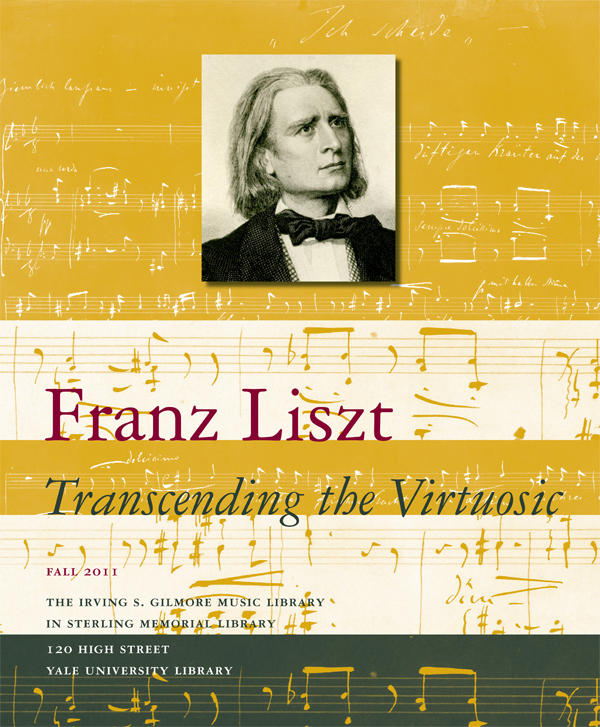Franz Liszt: Transcending the Virtuosic

The years between 1809 and 1813 saw the births of a remarkable series of composers: Felix Mendelssohn, Frédéric Chopin, Robert Schumann, Franz Liszt, Richard Wagner, and Giuseppe Verdi. By 2013, the Gilmore Music Library will have presented bicentenary exhibits honoring all six of these men. Liszt was born on October 22, 1811, so it is he who claims our attention in 2011. He had no trouble gaining the attention of his contemporaries, and he still looms large two hundred years later. An overpowering pianist, a strikingly innovative composer, a notable conductor, teacher, and author, and a magnetic personality, Liszt ranks among the most talented, influential, and colorful figures in music history.
Liszt showed his extraordinary talent at an early age, inducing his family to leave their native Hungary for the greater musical opportunities available in Vienna and Paris. He studied with Czerny and Salieri, among others, and when he was eleven he played for Beethoven, who—Liszt later claimed—bestowed a “kiss of consecration” on the boy’s forehead. By the time he had reached his teens, Liszt was already making major concert tours.
As a young man, Liszt came under the spell of Paganini, and undertook to reproduce the legendary violinist’s phenomenal effects on the piano. He succeeded in dazzling style; in countless performances throughout Europe in the 1830s and ’40s he established himself as the preeminent virtuoso of the age, renowned for his charisma as well as his unparalleled musical achievements. Today’s globe-trotting virtuosi are following in Liszt’s footsteps.
Like all the great performers of his era, Liszt wrote many pieces designed to show off his digital skills, but as his career progressed it became clear that his compositional talent went far beyond mere display. Large-scale masterworks such as the Piano Sonata and the Faust Symphony employed novel harmonic procedures, cyclic form, and thematic transformation to great effect, and his symphonic poems (such as Les Préludes) pioneered a whole new genre. These works helped make Liszt a leader (along with Wagner) of the “New German School” in the often rancorous aesthetic disputes of the mid-19th century. Their adversaries, whose ranks included Brahms, Joachim, and Hanslick, believed that the traditional forms still had much to offer. The debate eventually died down, but Liszt remained an innovator to the end of his life in 1886; his late piano works feature experimental harmonies that puzzled his contemporaries but captured the imagination of many 20th-century composers.
Liszt’s accomplishments were not limited to playing the piano and composing. He was also noteworthy as a conductor (he served as Kapellmeister in Weimar, and directed the premiere of Lohengrin), as a teacher (he taught a long list of distinguished students, including Hans von Bülow and Carl Tausig), and as an author (though he was not responsible for every word published under his name).
His personal life was as complex and varied as his musical career. He never married, but he had many romantic relationships, the most important of which were with Countess Marie d’Agoult and Princess Carolyne von Sayn-Wittgenstein, both of them married noblewomen separated from their husbands. Liszt and the Countess had three children; their daughter Cosima married first Hans von Bülow and later Richard Wagner. Although Liszt’s conduct was considered scandalous in some quarters, it did little to reduce his immense popularity and prestige.
His unconventional lifestyle notwithstanding, Liszt was staunchly Catholic, and in the 1860s he lived for several years in Rome, where he took minor orders and became friends with Pope Pius IX. From then on, he was known as Abbé Liszt and regularly appeared in ecclesiastical garb.
Our exhibit features several musical manuscripts and letters in Liszt’s own hand, as well as early printed editions of his music, two books about Liszt (an early biography and a recent novel), a medallion he kept on his night stand, and even a rose that he is said to have kissed. Several of the items on display come to us from the papers of Vladimir Horowitz, the most celebrated pianist of the 20th century and a keen admirer of Liszt.
—Richard Boursy, Archivist
Exhibit by Richard Boursy.
Web design by Rémi Castonguay.
Poster design by Angie Hurlbut.
Special thanks to: Emily Ferrigno, Eva Heater, Suzanne Lovejoy, and Paula Zyats for their help with this exhibit.
